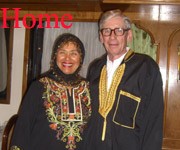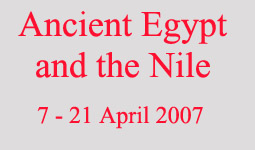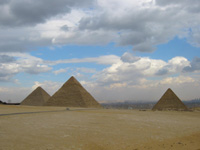Page 1 2 3 4 5 6 7 8 9 10 11 12 13 14 15 16 17 18 19 [History]
Tuesday, 10 April. We have a very busy schedule today. We had breakfast at 6:30 and by 7:30 were on the bus en route to Giza,
a town right next to Cairo. Giza, of course, is the site of Egypt's most famous
pyramids. This was part of the great necropolis of Memphis, capital of Egypt's
Old Kingdom.
The pyramids soon came into view, but the setting was quite
different than we had expected. The pyramids don't stand in a flat, sandy
desert, but on very uneven rocky outcroppings. There are modern buildings in
sight very nearby, especially by the Sphinx. A huge paved parking area for
tourist buses is almost at the base of the Great Pyramid, and a paved road for
the buses runs right between the pyramids.
First, though, a little background. The three big pyramids at Giza are: the Great Pyramid of Khufu (Cheops); the pyramid of his son, Kafhre (Chephren); and the pyramid of Kafhre's son, Menkaura (Mycerinus). Khufu's pyramid was the largest (481 feet tall, about 756 feet square, and covering about 13 acres). It was completed around 2560 B.C, and the others not much later. That's more than 4500 years ago! Khafre's pyramid is not quite as large as that of his father but actually looks taller because it was built on a slightly higher part of the plateau. It's the only pyramid that retains part of its original polished limestone cap. This pyramid was about 705 feet on each side and was 471 feet high. The last and smallest of the Giza pyramids was the pyramid of Menkaure. Each side measures about 350 feet, and the structure's completed height was about 216 feet high. We got off the bus at the Khufu pyramid about 8:00 and were
given half an hour to look around and take pictures. There were tourist police
everywhere, on foot, on camels, and in vehicles. And for every policeman there
were at least twenty aggressive "vendors" offering post cards (20 for $1),
scarabs and other jewelry, T-shirts, arab head dress, and every imaginable type
of souvenir. Two policeman on camels posed for a picture, then immediately
demanded "baksheesh" (a tip or bribe). This didn't come as a surprise, and I'd
come prepared with a pocketful of E.5 bills (88 cents). A handsome young policeman on
foot offered to take our picture in front of Khufu's pyramid (and did an
excellent job), then, with a broad smile, held out his hand. Well worth the E.5!
We walked around to another side of Khufu's pyramid where a museum has been built at the base of the pyramid to display Khufu's solar boat. We had the option of seeing that or going inside Khufu's pyramid. There wasn't time to do both. Going into the pyramid required descending a long sloping shaft in a bent over position, and Jane wasn't up to that. The Solar Boat Museum was very interesting. It contains the actual boat (reassembled) that was used in the funerary ceremonies of the Pharaoh Khufu over 4500 year ago. This boat, made of cedar, was 142 feet long and 20 feet wide. After the ceremonies, the boat was dismantled (1224 pieces) and buried in a pit next to the pyramid. Back on the bus, we took the road between the pyramids to a high, flat area where we had an unobstructed view of all three major pyramids, as well as of the three small pyramids adjacent to the Menkaura pyramid. This vantage point was swarming , not only with the normal vendors, but also with costumed men on foot or mounted on camels or horses, all running and posing fiercely in front of our camera the instant I raised it to photograph the pyramids. Baksheesh!
Continuing down the road, the bus took us to an open area in front of the Great Sphinx. With the body of a lion and the head of a pharaoh, this huge statue was carved out of the limestone bedrock around 2500 B.C. (Some say it was much earlier.) Because the top of its head was the original level of the rock, it sits very low in relation to its surroundings, effectively in a hole. That makes it appear smaller than it is (about 240 feet long, 20 feet wide & 65 feet high). The Sphinx is directly in front of Khafre's pyramid and is believed to have his face. Just in front of the Sphinx are the remains of two temples, the Sphinx Temple and the Valley Temple. Both were built from huge limestone blocks excavated from around the Sphinx before it was carved.
By entering through the Valley Temple, we were able to walk along the entire length of the Sphinx and even get behind it. The Temple itself was impressive, but it was so mobbed by tourists pushing their way to and from the Sphinx that there wasn't much chance to look around.
Then it was time to head for the bus. We'd spent four hours at Giza, but we could have used at least two more. That would have given us time to go inside Khufu's Pyramid and maybe even take a camel ride. It's a shame to come all this way and not have enough time at what is probably the greatest attraction.
Page 1 2 3 4 5 6 7 8 9 10 11 12 13 14 15 16 17 18 19 [History]
Copyright © 2000-2023 DarrellPeck.com All rights
reserved. | |||||||||||||




















